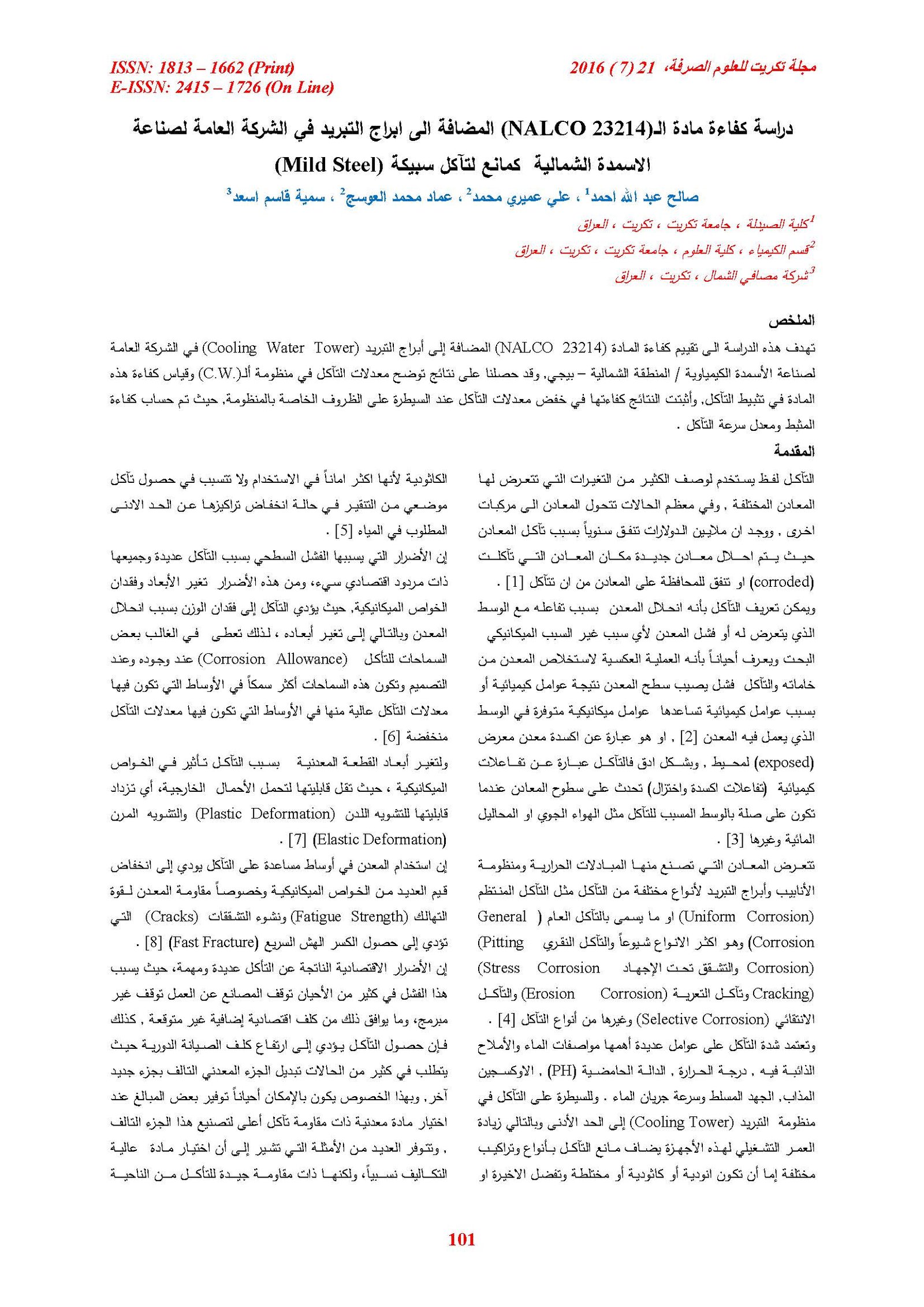The Study Of The Efficiency Of (NALCO 23214) Substance Added To The Cooling Towers At The Northern General Company For The Manufacture Of Fertilizer As Corrosive Inhibitor For (Mild Steel) Alloy
Main Article Content
Abstract
This study aims to appraisal the qualification of (NALCO 23214) which is used as added substance to Cooling Water Tower in General Company for Chemical Fertilizers Industry / North Region-Baiji. Already the results which we are obtained show the corrosion rates in (C.W.) system, and measuring this substance efficiency in corrosion inhibition. The results showed the substance qualification in reduction of corrosion rates when control on the special conditions in system, so the inhibitor qualification and corrosion rate were calculated.
Article Details

This work is licensed under a Creative Commons Attribution 4.0 International License.
Tikrit Journal of Pure Science is licensed under the Creative Commons Attribution 4.0 International License, which allows users to copy, create extracts, abstracts, and new works from the article, alter and revise the article, and make commercial use of the article (including reuse and/or resale of the article by commercial entities), provided the user gives appropriate credit (with a link to the formal publication through the relevant DOI), provides a link to the license, indicates if changes were made, and the licensor is not represented as endorsing the use made of the work. The authors hold the copyright for their published work on the Tikrit J. Pure Sci. website, while Tikrit J. Pure Sci. is responsible for appreciate citation of their work, which is released under CC-BY-4.0, enabling the unrestricted use, distribution, and reproduction of an article in any medium, provided that the original work is properly cited.
References
3- V. Kadek, L. Lepin. 1972. Proc. 5th Congress on Metallic Corrosion, Tokyo, p. 560.
4- J. Roti,, K. Saeder. “A comprehensive evaluation of molybdate based cooling water treatment technology.” Cooling Tower Institute, 1988 Annual Meeting, Paper TP-88-03.
5- J. Z. Lumsden, Szklarska - Smialowska. 1978. Corrosion, 34(5):169.
6-V. S. Agarwala, “Inhibition of Corrosion Fatigue-Assisted Failures in High Strength Alloys, ”in “Corrosion Inhibition, ”R. H. Hausler, ed., (Houston, TX: NACE, 1988), p. 79.
7-V. S. Agarwala, “Modification of Crack-tip Chemistry to Inhibit Corrosion and Stress Corrosion Cracking in High Strength Alloys,”in “Embrittlement by the Localized Crack Environment,” R.P. Gangloff, ed., ( Warrendale, PA: AIME, 1984), p. 405.
8-G. E. Fodor, in “Reviews on Corrosion Inhibitor Science and Technology,” A. Raman and P. Labine, eds. (Houston, TX: NACE, 1993), p. II-17-1.
9-E. M. Mora, J. M. Bastidas, Corrosion Prevention and Control, 34, 6 (1987): p. 143.
10-N. Hackerrman., in “Fundamentals of Inhibitors,” NACE Basic Corrosion Course, (Houston, TX: NACE, 1965).
11-K. L. Vasanth, “Vapor Phase Corrosion Inhibitors for AEGIS Ships-an Update, ”Proc. the 3rd Combined Combat Systems and Surface Ship Corrosion Control Conference, Naval Surface Warfare Center, Louisville, KY., Vol. I, Section 3, 26-30 June 1995.
